Vendor and Purchaser Law: Case Analysis of Bakhos and Urban House
VerifiedAdded on 2019/11/29
|11
|2214
|511
Case Study
AI Summary
This document presents a comprehensive analysis of two key cases in vendor and purchaser law: Bakhos v Fenner & Anor [2007] NSWSC 641 and Urban House v Purnell Bros [2007] NSWSC 1248. The analysis focuses on the issues of property damage, contract rescission, and the application of the Conveyancing Act 1999. The Bakhos case examines the liability of a vendor for property damage caused by fire, determining whether the damage was substantial enough to allow the purchaser to rescind the contract under section 66L of the Act. The Urban House case explores similar issues, focusing on whether a purchaser could rescind a contract due to fire damage and recover the deposit. Both cases delve into the rights and obligations of vendors and purchasers regarding property damage, insurance, and the concept of substantial damage as defined by the Conveyancing Act 1999. The document reviews relevant legislation, case law, and provides detailed analysis and conclusions for each case, offering valuable insights into property law principles.
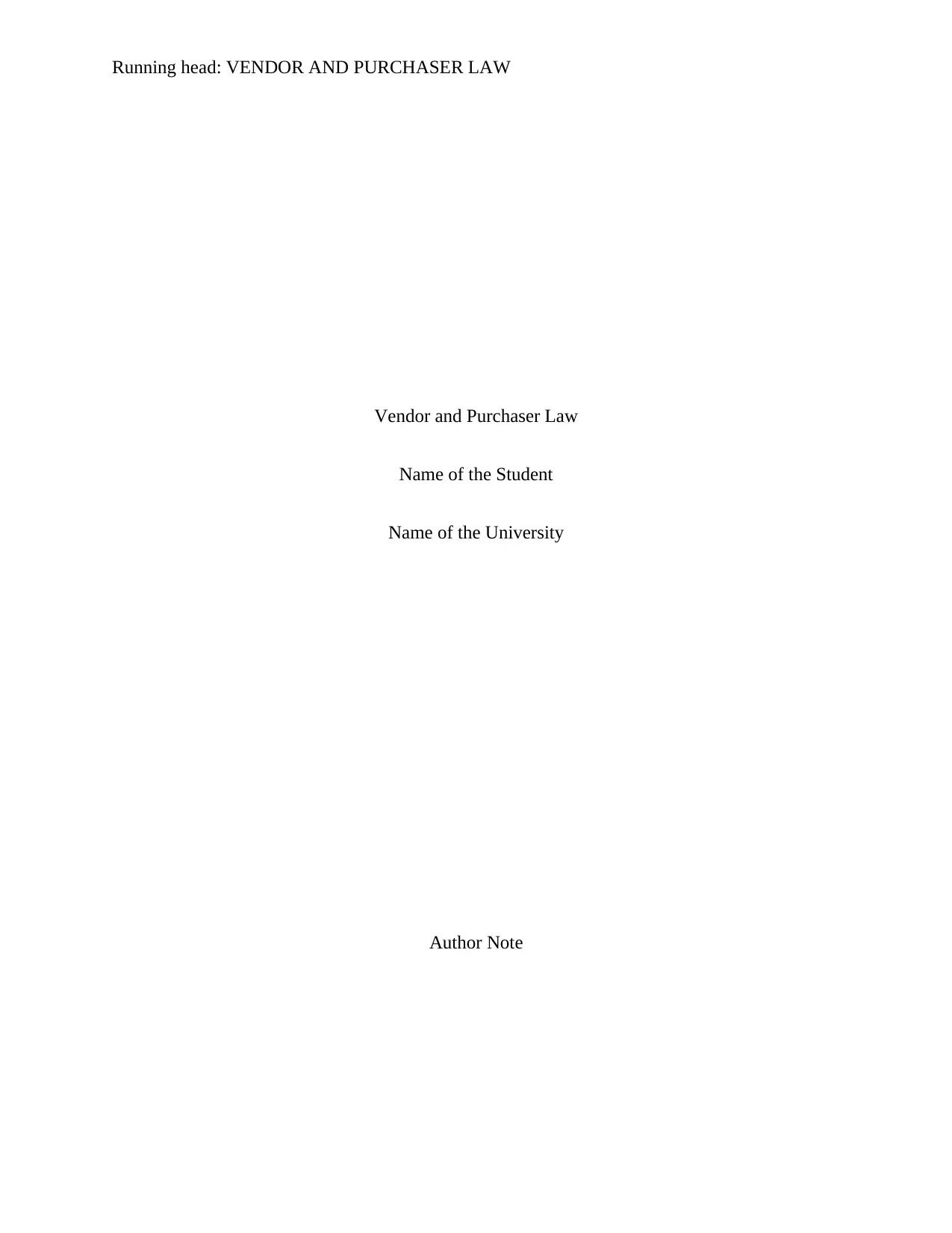
Running head: VENDOR AND PURCHASER LAW
Vendor and Purchaser Law
Name of the Student
Name of the University
Author Note
Vendor and Purchaser Law
Name of the Student
Name of the University
Author Note
Paraphrase This Document
Need a fresh take? Get an instant paraphrase of this document with our AI Paraphraser
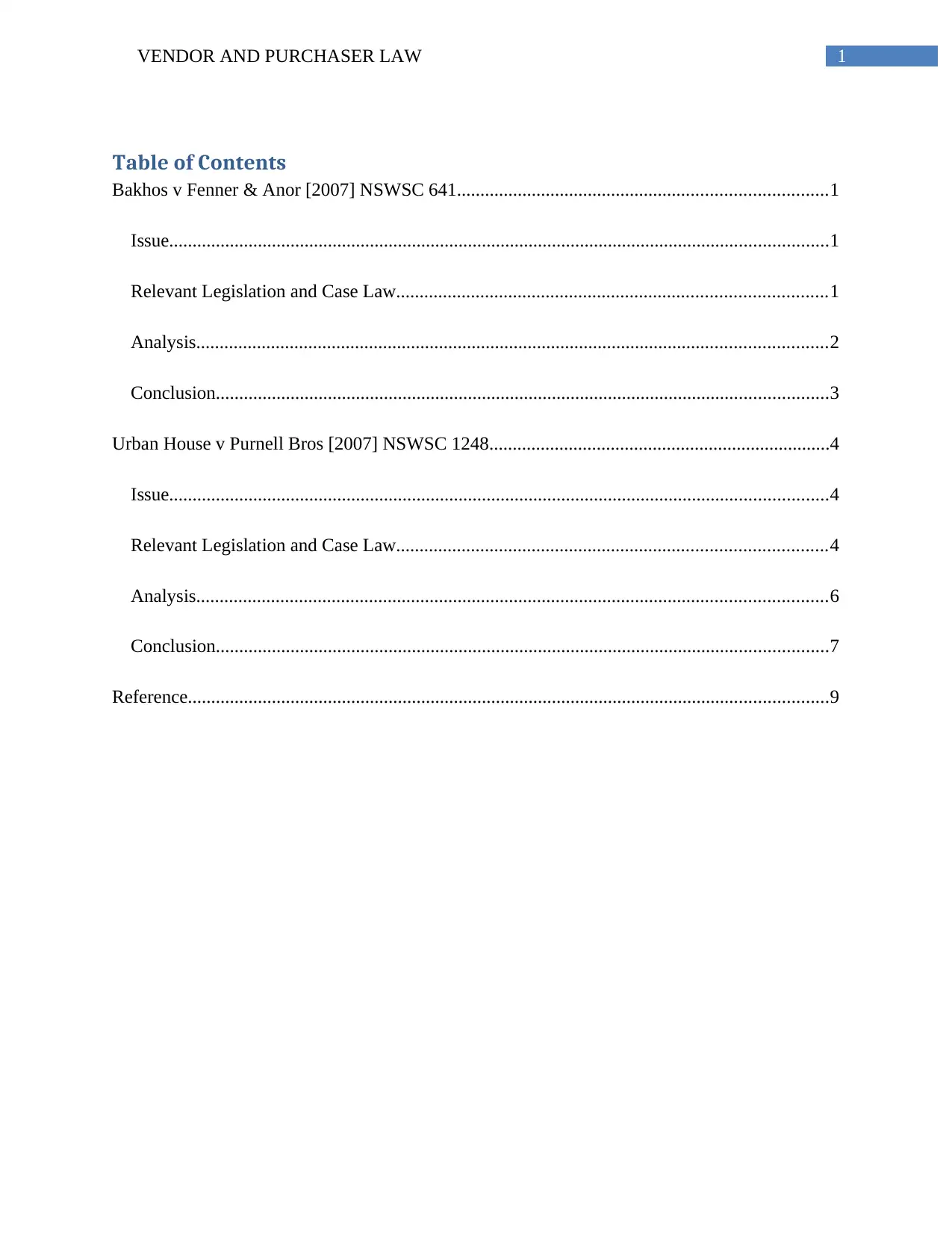
1VENDOR AND PURCHASER LAW
Table of Contents
Bakhos v Fenner & Anor [2007] NSWSC 641...............................................................................1
Issue.............................................................................................................................................1
Relevant Legislation and Case Law............................................................................................1
Analysis.......................................................................................................................................2
Conclusion...................................................................................................................................3
Urban House v Purnell Bros [2007] NSWSC 1248.........................................................................4
Issue.............................................................................................................................................4
Relevant Legislation and Case Law............................................................................................4
Analysis.......................................................................................................................................6
Conclusion...................................................................................................................................7
Reference.........................................................................................................................................9
Table of Contents
Bakhos v Fenner & Anor [2007] NSWSC 641...............................................................................1
Issue.............................................................................................................................................1
Relevant Legislation and Case Law............................................................................................1
Analysis.......................................................................................................................................2
Conclusion...................................................................................................................................3
Urban House v Purnell Bros [2007] NSWSC 1248.........................................................................4
Issue.............................................................................................................................................4
Relevant Legislation and Case Law............................................................................................4
Analysis.......................................................................................................................................6
Conclusion...................................................................................................................................7
Reference.........................................................................................................................................9
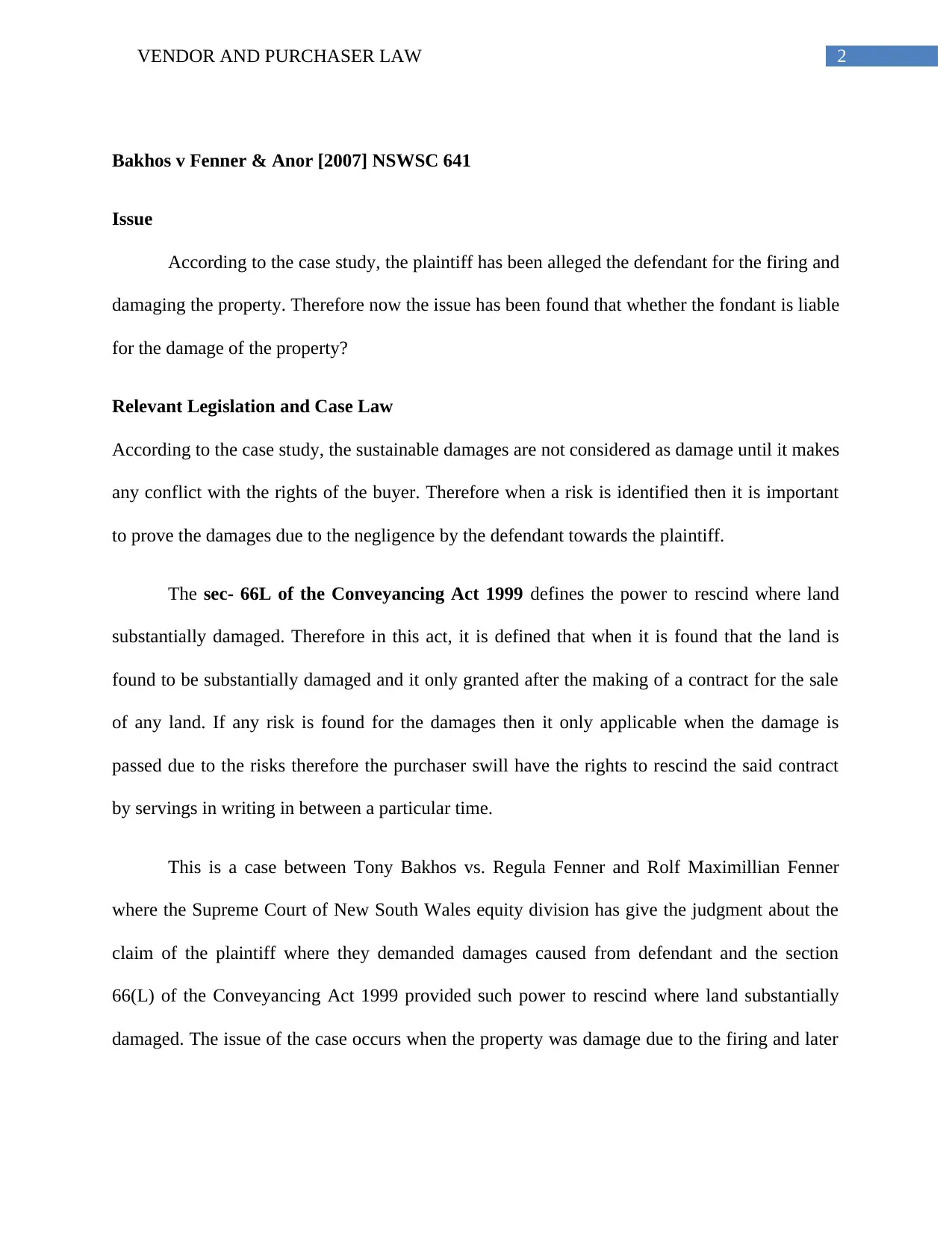
2VENDOR AND PURCHASER LAW
Bakhos v Fenner & Anor [2007] NSWSC 641
Issue
According to the case study, the plaintiff has been alleged the defendant for the firing and
damaging the property. Therefore now the issue has been found that whether the fondant is liable
for the damage of the property?
Relevant Legislation and Case Law
According to the case study, the sustainable damages are not considered as damage until it makes
any conflict with the rights of the buyer. Therefore when a risk is identified then it is important
to prove the damages due to the negligence by the defendant towards the plaintiff.
The sec- 66L of the Conveyancing Act 1999 defines the power to rescind where land
substantially damaged. Therefore in this act, it is defined that when it is found that the land is
found to be substantially damaged and it only granted after the making of a contract for the sale
of any land. If any risk is found for the damages then it only applicable when the damage is
passed due to the risks therefore the purchaser swill have the rights to rescind the said contract
by servings in writing in between a particular time.
This is a case between Tony Bakhos vs. Regula Fenner and Rolf Maximillian Fenner
where the Supreme Court of New South Wales equity division has give the judgment about the
claim of the plaintiff where they demanded damages caused from defendant and the section
66(L) of the Conveyancing Act 1999 provided such power to rescind where land substantially
damaged. The issue of the case occurs when the property was damage due to the firing and later
Bakhos v Fenner & Anor [2007] NSWSC 641
Issue
According to the case study, the plaintiff has been alleged the defendant for the firing and
damaging the property. Therefore now the issue has been found that whether the fondant is liable
for the damage of the property?
Relevant Legislation and Case Law
According to the case study, the sustainable damages are not considered as damage until it makes
any conflict with the rights of the buyer. Therefore when a risk is identified then it is important
to prove the damages due to the negligence by the defendant towards the plaintiff.
The sec- 66L of the Conveyancing Act 1999 defines the power to rescind where land
substantially damaged. Therefore in this act, it is defined that when it is found that the land is
found to be substantially damaged and it only granted after the making of a contract for the sale
of any land. If any risk is found for the damages then it only applicable when the damage is
passed due to the risks therefore the purchaser swill have the rights to rescind the said contract
by servings in writing in between a particular time.
This is a case between Tony Bakhos vs. Regula Fenner and Rolf Maximillian Fenner
where the Supreme Court of New South Wales equity division has give the judgment about the
claim of the plaintiff where they demanded damages caused from defendant and the section
66(L) of the Conveyancing Act 1999 provided such power to rescind where land substantially
damaged. The issue of the case occurs when the property was damage due to the firing and later
⊘ This is a preview!⊘
Do you want full access?
Subscribe today to unlock all pages.

Trusted by 1+ million students worldwide
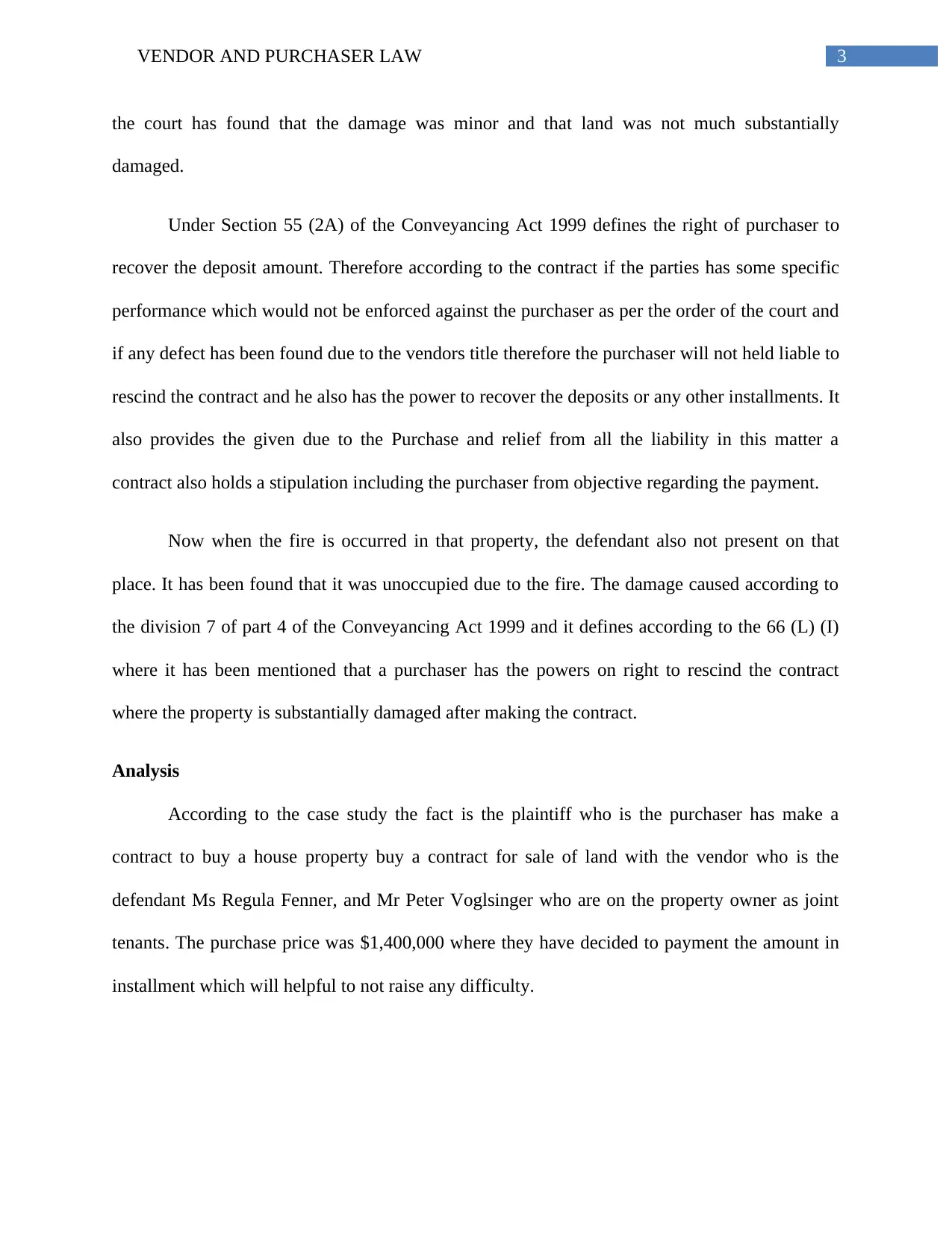
3VENDOR AND PURCHASER LAW
the court has found that the damage was minor and that land was not much substantially
damaged.
Under Section 55 (2A) of the Conveyancing Act 1999 defines the right of purchaser to
recover the deposit amount. Therefore according to the contract if the parties has some specific
performance which would not be enforced against the purchaser as per the order of the court and
if any defect has been found due to the vendors title therefore the purchaser will not held liable to
rescind the contract and he also has the power to recover the deposits or any other installments. It
also provides the given due to the Purchase and relief from all the liability in this matter a
contract also holds a stipulation including the purchaser from objective regarding the payment.
Now when the fire is occurred in that property, the defendant also not present on that
place. It has been found that it was unoccupied due to the fire. The damage caused according to
the division 7 of part 4 of the Conveyancing Act 1999 and it defines according to the 66 (L) (I)
where it has been mentioned that a purchaser has the powers on right to rescind the contract
where the property is substantially damaged after making the contract.
Analysis
According to the case study the fact is the plaintiff who is the purchaser has make a
contract to buy a house property buy a contract for sale of land with the vendor who is the
defendant Ms Regula Fenner, and Mr Peter Voglsinger who are on the property owner as joint
tenants. The purchase price was $1,400,000 where they have decided to payment the amount in
installment which will helpful to not raise any difficulty.
the court has found that the damage was minor and that land was not much substantially
damaged.
Under Section 55 (2A) of the Conveyancing Act 1999 defines the right of purchaser to
recover the deposit amount. Therefore according to the contract if the parties has some specific
performance which would not be enforced against the purchaser as per the order of the court and
if any defect has been found due to the vendors title therefore the purchaser will not held liable to
rescind the contract and he also has the power to recover the deposits or any other installments. It
also provides the given due to the Purchase and relief from all the liability in this matter a
contract also holds a stipulation including the purchaser from objective regarding the payment.
Now when the fire is occurred in that property, the defendant also not present on that
place. It has been found that it was unoccupied due to the fire. The damage caused according to
the division 7 of part 4 of the Conveyancing Act 1999 and it defines according to the 66 (L) (I)
where it has been mentioned that a purchaser has the powers on right to rescind the contract
where the property is substantially damaged after making the contract.
Analysis
According to the case study the fact is the plaintiff who is the purchaser has make a
contract to buy a house property buy a contract for sale of land with the vendor who is the
defendant Ms Regula Fenner, and Mr Peter Voglsinger who are on the property owner as joint
tenants. The purchase price was $1,400,000 where they have decided to payment the amount in
installment which will helpful to not raise any difficulty.
Paraphrase This Document
Need a fresh take? Get an instant paraphrase of this document with our AI Paraphraser
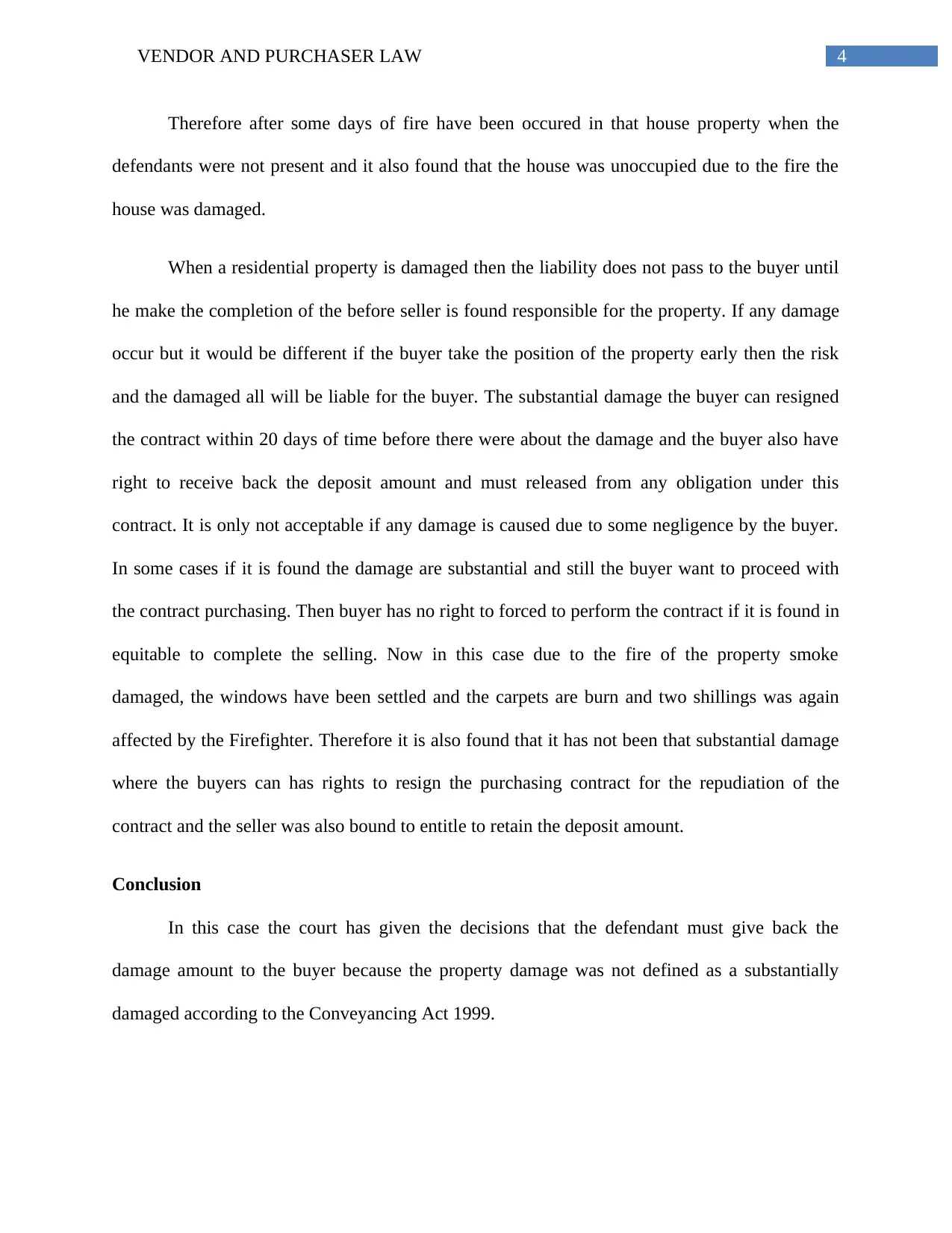
4VENDOR AND PURCHASER LAW
Therefore after some days of fire have been occured in that house property when the
defendants were not present and it also found that the house was unoccupied due to the fire the
house was damaged.
When a residential property is damaged then the liability does not pass to the buyer until
he make the completion of the before seller is found responsible for the property. If any damage
occur but it would be different if the buyer take the position of the property early then the risk
and the damaged all will be liable for the buyer. The substantial damage the buyer can resigned
the contract within 20 days of time before there were about the damage and the buyer also have
right to receive back the deposit amount and must released from any obligation under this
contract. It is only not acceptable if any damage is caused due to some negligence by the buyer.
In some cases if it is found the damage are substantial and still the buyer want to proceed with
the contract purchasing. Then buyer has no right to forced to perform the contract if it is found in
equitable to complete the selling. Now in this case due to the fire of the property smoke
damaged, the windows have been settled and the carpets are burn and two shillings was again
affected by the Firefighter. Therefore it is also found that it has not been that substantial damage
where the buyers can has rights to resign the purchasing contract for the repudiation of the
contract and the seller was also bound to entitle to retain the deposit amount.
Conclusion
In this case the court has given the decisions that the defendant must give back the
damage amount to the buyer because the property damage was not defined as a substantially
damaged according to the Conveyancing Act 1999.
Therefore after some days of fire have been occured in that house property when the
defendants were not present and it also found that the house was unoccupied due to the fire the
house was damaged.
When a residential property is damaged then the liability does not pass to the buyer until
he make the completion of the before seller is found responsible for the property. If any damage
occur but it would be different if the buyer take the position of the property early then the risk
and the damaged all will be liable for the buyer. The substantial damage the buyer can resigned
the contract within 20 days of time before there were about the damage and the buyer also have
right to receive back the deposit amount and must released from any obligation under this
contract. It is only not acceptable if any damage is caused due to some negligence by the buyer.
In some cases if it is found the damage are substantial and still the buyer want to proceed with
the contract purchasing. Then buyer has no right to forced to perform the contract if it is found in
equitable to complete the selling. Now in this case due to the fire of the property smoke
damaged, the windows have been settled and the carpets are burn and two shillings was again
affected by the Firefighter. Therefore it is also found that it has not been that substantial damage
where the buyers can has rights to resign the purchasing contract for the repudiation of the
contract and the seller was also bound to entitle to retain the deposit amount.
Conclusion
In this case the court has given the decisions that the defendant must give back the
damage amount to the buyer because the property damage was not defined as a substantially
damaged according to the Conveyancing Act 1999.

5VENDOR AND PURCHASER LAW
⊘ This is a preview!⊘
Do you want full access?
Subscribe today to unlock all pages.

Trusted by 1+ million students worldwide
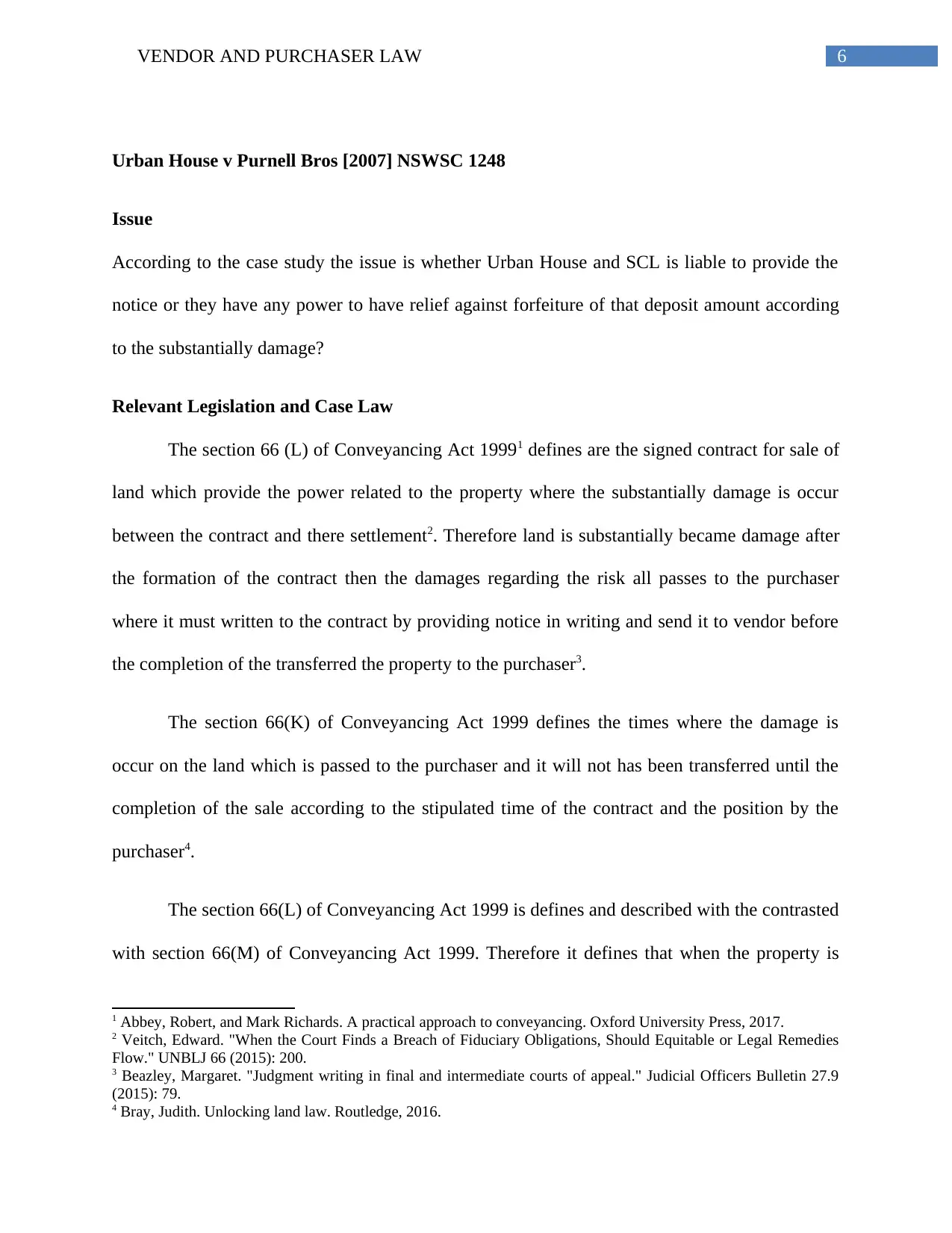
6VENDOR AND PURCHASER LAW
Urban House v Purnell Bros [2007] NSWSC 1248
Issue
According to the case study the issue is whether Urban House and SCL is liable to provide the
notice or they have any power to have relief against forfeiture of that deposit amount according
to the substantially damage?
Relevant Legislation and Case Law
The section 66 (L) of Conveyancing Act 19991 defines are the signed contract for sale of
land which provide the power related to the property where the substantially damage is occur
between the contract and there settlement2. Therefore land is substantially became damage after
the formation of the contract then the damages regarding the risk all passes to the purchaser
where it must written to the contract by providing notice in writing and send it to vendor before
the completion of the transferred the property to the purchaser3.
The section 66(K) of Conveyancing Act 1999 defines the times where the damage is
occur on the land which is passed to the purchaser and it will not has been transferred until the
completion of the sale according to the stipulated time of the contract and the position by the
purchaser4.
The section 66(L) of Conveyancing Act 1999 is defines and described with the contrasted
with section 66(M) of Conveyancing Act 1999. Therefore it defines that when the property is
1 Abbey, Robert, and Mark Richards. A practical approach to conveyancing. Oxford University Press, 2017.
2 Veitch, Edward. "When the Court Finds a Breach of Fiduciary Obligations, Should Equitable or Legal Remedies
Flow." UNBLJ 66 (2015): 200.
3 Beazley, Margaret. "Judgment writing in final and intermediate courts of appeal." Judicial Officers Bulletin 27.9
(2015): 79.
4 Bray, Judith. Unlocking land law. Routledge, 2016.
Urban House v Purnell Bros [2007] NSWSC 1248
Issue
According to the case study the issue is whether Urban House and SCL is liable to provide the
notice or they have any power to have relief against forfeiture of that deposit amount according
to the substantially damage?
Relevant Legislation and Case Law
The section 66 (L) of Conveyancing Act 19991 defines are the signed contract for sale of
land which provide the power related to the property where the substantially damage is occur
between the contract and there settlement2. Therefore land is substantially became damage after
the formation of the contract then the damages regarding the risk all passes to the purchaser
where it must written to the contract by providing notice in writing and send it to vendor before
the completion of the transferred the property to the purchaser3.
The section 66(K) of Conveyancing Act 1999 defines the times where the damage is
occur on the land which is passed to the purchaser and it will not has been transferred until the
completion of the sale according to the stipulated time of the contract and the position by the
purchaser4.
The section 66(L) of Conveyancing Act 1999 is defines and described with the contrasted
with section 66(M) of Conveyancing Act 1999. Therefore it defines that when the property is
1 Abbey, Robert, and Mark Richards. A practical approach to conveyancing. Oxford University Press, 2017.
2 Veitch, Edward. "When the Court Finds a Breach of Fiduciary Obligations, Should Equitable or Legal Remedies
Flow." UNBLJ 66 (2015): 200.
3 Beazley, Margaret. "Judgment writing in final and intermediate courts of appeal." Judicial Officers Bulletin 27.9
(2015): 79.
4 Bray, Judith. Unlocking land law. Routledge, 2016.
Paraphrase This Document
Need a fresh take? Get an instant paraphrase of this document with our AI Paraphraser
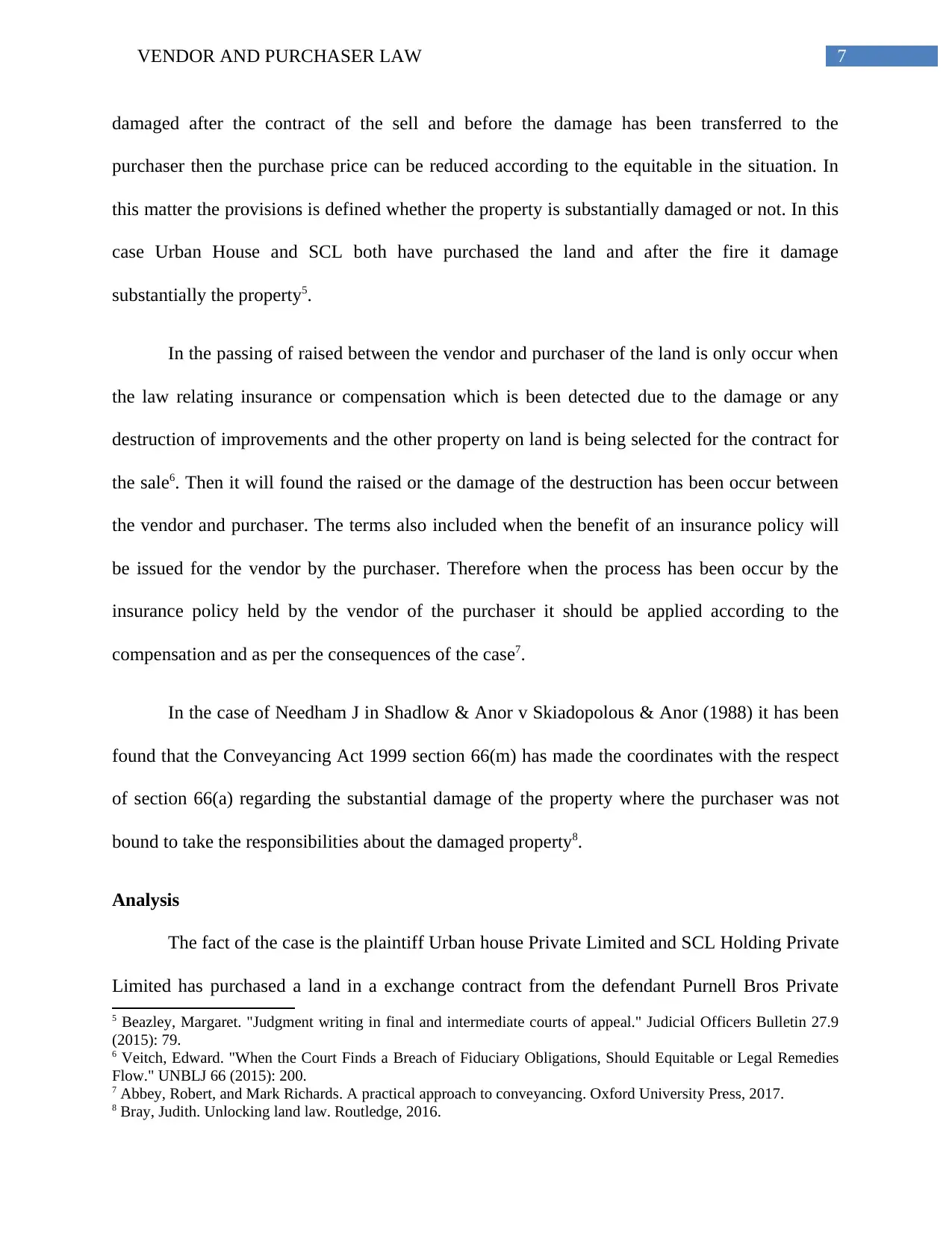
7VENDOR AND PURCHASER LAW
damaged after the contract of the sell and before the damage has been transferred to the
purchaser then the purchase price can be reduced according to the equitable in the situation. In
this matter the provisions is defined whether the property is substantially damaged or not. In this
case Urban House and SCL both have purchased the land and after the fire it damage
substantially the property5.
In the passing of raised between the vendor and purchaser of the land is only occur when
the law relating insurance or compensation which is been detected due to the damage or any
destruction of improvements and the other property on land is being selected for the contract for
the sale6. Then it will found the raised or the damage of the destruction has been occur between
the vendor and purchaser. The terms also included when the benefit of an insurance policy will
be issued for the vendor by the purchaser. Therefore when the process has been occur by the
insurance policy held by the vendor of the purchaser it should be applied according to the
compensation and as per the consequences of the case7.
In the case of Needham J in Shadlow & Anor v Skiadopolous & Anor (1988) it has been
found that the Conveyancing Act 1999 section 66(m) has made the coordinates with the respect
of section 66(a) regarding the substantial damage of the property where the purchaser was not
bound to take the responsibilities about the damaged property8.
Analysis
The fact of the case is the plaintiff Urban house Private Limited and SCL Holding Private
Limited has purchased a land in a exchange contract from the defendant Purnell Bros Private
5 Beazley, Margaret. "Judgment writing in final and intermediate courts of appeal." Judicial Officers Bulletin 27.9
(2015): 79.
6 Veitch, Edward. "When the Court Finds a Breach of Fiduciary Obligations, Should Equitable or Legal Remedies
Flow." UNBLJ 66 (2015): 200.
7 Abbey, Robert, and Mark Richards. A practical approach to conveyancing. Oxford University Press, 2017.
8 Bray, Judith. Unlocking land law. Routledge, 2016.
damaged after the contract of the sell and before the damage has been transferred to the
purchaser then the purchase price can be reduced according to the equitable in the situation. In
this matter the provisions is defined whether the property is substantially damaged or not. In this
case Urban House and SCL both have purchased the land and after the fire it damage
substantially the property5.
In the passing of raised between the vendor and purchaser of the land is only occur when
the law relating insurance or compensation which is been detected due to the damage or any
destruction of improvements and the other property on land is being selected for the contract for
the sale6. Then it will found the raised or the damage of the destruction has been occur between
the vendor and purchaser. The terms also included when the benefit of an insurance policy will
be issued for the vendor by the purchaser. Therefore when the process has been occur by the
insurance policy held by the vendor of the purchaser it should be applied according to the
compensation and as per the consequences of the case7.
In the case of Needham J in Shadlow & Anor v Skiadopolous & Anor (1988) it has been
found that the Conveyancing Act 1999 section 66(m) has made the coordinates with the respect
of section 66(a) regarding the substantial damage of the property where the purchaser was not
bound to take the responsibilities about the damaged property8.
Analysis
The fact of the case is the plaintiff Urban house Private Limited and SCL Holding Private
Limited has purchased a land in a exchange contract from the defendant Purnell Bros Private
5 Beazley, Margaret. "Judgment writing in final and intermediate courts of appeal." Judicial Officers Bulletin 27.9
(2015): 79.
6 Veitch, Edward. "When the Court Finds a Breach of Fiduciary Obligations, Should Equitable or Legal Remedies
Flow." UNBLJ 66 (2015): 200.
7 Abbey, Robert, and Mark Richards. A practical approach to conveyancing. Oxford University Press, 2017.
8 Bray, Judith. Unlocking land law. Routledge, 2016.
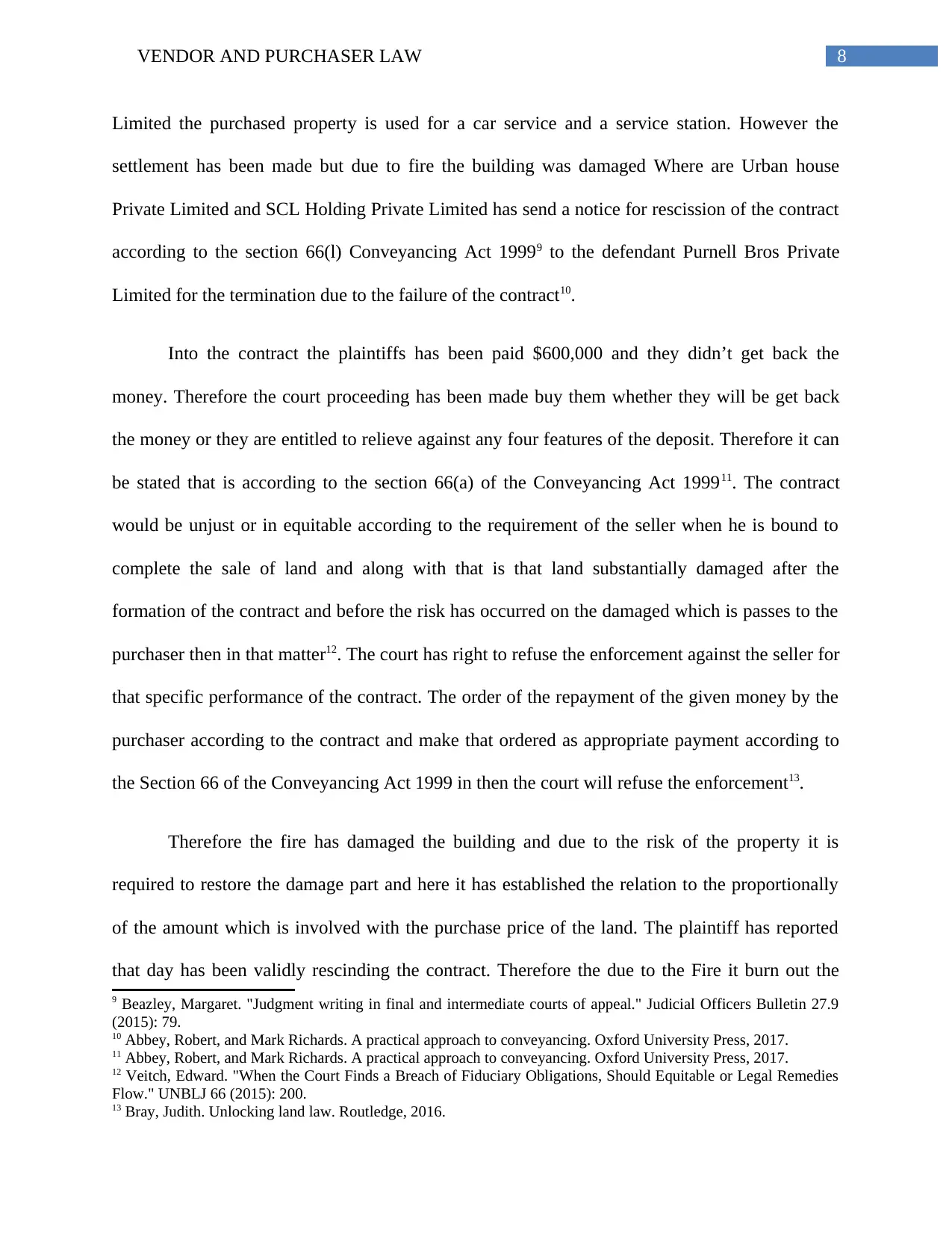
8VENDOR AND PURCHASER LAW
Limited the purchased property is used for a car service and a service station. However the
settlement has been made but due to fire the building was damaged Where are Urban house
Private Limited and SCL Holding Private Limited has send a notice for rescission of the contract
according to the section 66(l) Conveyancing Act 19999 to the defendant Purnell Bros Private
Limited for the termination due to the failure of the contract10.
Into the contract the plaintiffs has been paid $600,000 and they didn’t get back the
money. Therefore the court proceeding has been made buy them whether they will be get back
the money or they are entitled to relieve against any four features of the deposit. Therefore it can
be stated that is according to the section 66(a) of the Conveyancing Act 199911. The contract
would be unjust or in equitable according to the requirement of the seller when he is bound to
complete the sale of land and along with that is that land substantially damaged after the
formation of the contract and before the risk has occurred on the damaged which is passes to the
purchaser then in that matter12. The court has right to refuse the enforcement against the seller for
that specific performance of the contract. The order of the repayment of the given money by the
purchaser according to the contract and make that ordered as appropriate payment according to
the Section 66 of the Conveyancing Act 1999 in then the court will refuse the enforcement13.
Therefore the fire has damaged the building and due to the risk of the property it is
required to restore the damage part and here it has established the relation to the proportionally
of the amount which is involved with the purchase price of the land. The plaintiff has reported
that day has been validly rescinding the contract. Therefore the due to the Fire it burn out the
9 Beazley, Margaret. "Judgment writing in final and intermediate courts of appeal." Judicial Officers Bulletin 27.9
(2015): 79.
10 Abbey, Robert, and Mark Richards. A practical approach to conveyancing. Oxford University Press, 2017.
11 Abbey, Robert, and Mark Richards. A practical approach to conveyancing. Oxford University Press, 2017.
12 Veitch, Edward. "When the Court Finds a Breach of Fiduciary Obligations, Should Equitable or Legal Remedies
Flow." UNBLJ 66 (2015): 200.
13 Bray, Judith. Unlocking land law. Routledge, 2016.
Limited the purchased property is used for a car service and a service station. However the
settlement has been made but due to fire the building was damaged Where are Urban house
Private Limited and SCL Holding Private Limited has send a notice for rescission of the contract
according to the section 66(l) Conveyancing Act 19999 to the defendant Purnell Bros Private
Limited for the termination due to the failure of the contract10.
Into the contract the plaintiffs has been paid $600,000 and they didn’t get back the
money. Therefore the court proceeding has been made buy them whether they will be get back
the money or they are entitled to relieve against any four features of the deposit. Therefore it can
be stated that is according to the section 66(a) of the Conveyancing Act 199911. The contract
would be unjust or in equitable according to the requirement of the seller when he is bound to
complete the sale of land and along with that is that land substantially damaged after the
formation of the contract and before the risk has occurred on the damaged which is passes to the
purchaser then in that matter12. The court has right to refuse the enforcement against the seller for
that specific performance of the contract. The order of the repayment of the given money by the
purchaser according to the contract and make that ordered as appropriate payment according to
the Section 66 of the Conveyancing Act 1999 in then the court will refuse the enforcement13.
Therefore the fire has damaged the building and due to the risk of the property it is
required to restore the damage part and here it has established the relation to the proportionally
of the amount which is involved with the purchase price of the land. The plaintiff has reported
that day has been validly rescinding the contract. Therefore the due to the Fire it burn out the
9 Beazley, Margaret. "Judgment writing in final and intermediate courts of appeal." Judicial Officers Bulletin 27.9
(2015): 79.
10 Abbey, Robert, and Mark Richards. A practical approach to conveyancing. Oxford University Press, 2017.
11 Abbey, Robert, and Mark Richards. A practical approach to conveyancing. Oxford University Press, 2017.
12 Veitch, Edward. "When the Court Finds a Breach of Fiduciary Obligations, Should Equitable or Legal Remedies
Flow." UNBLJ 66 (2015): 200.
13 Bray, Judith. Unlocking land law. Routledge, 2016.
⊘ This is a preview!⊘
Do you want full access?
Subscribe today to unlock all pages.

Trusted by 1+ million students worldwide
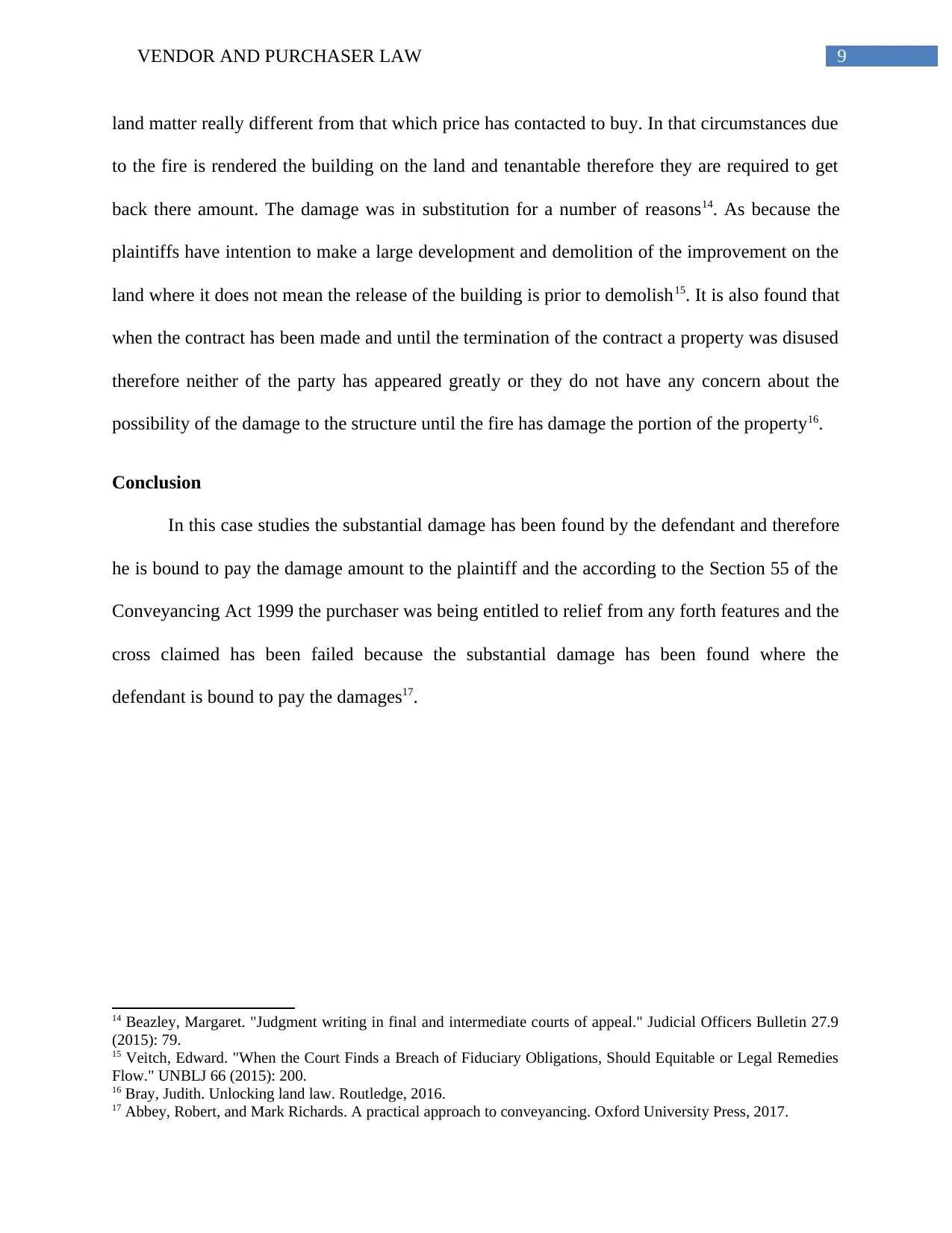
9VENDOR AND PURCHASER LAW
land matter really different from that which price has contacted to buy. In that circumstances due
to the fire is rendered the building on the land and tenantable therefore they are required to get
back there amount. The damage was in substitution for a number of reasons14. As because the
plaintiffs have intention to make a large development and demolition of the improvement on the
land where it does not mean the release of the building is prior to demolish15. It is also found that
when the contract has been made and until the termination of the contract a property was disused
therefore neither of the party has appeared greatly or they do not have any concern about the
possibility of the damage to the structure until the fire has damage the portion of the property16.
Conclusion
In this case studies the substantial damage has been found by the defendant and therefore
he is bound to pay the damage amount to the plaintiff and the according to the Section 55 of the
Conveyancing Act 1999 the purchaser was being entitled to relief from any forth features and the
cross claimed has been failed because the substantial damage has been found where the
defendant is bound to pay the damages17.
14 Beazley, Margaret. "Judgment writing in final and intermediate courts of appeal." Judicial Officers Bulletin 27.9
(2015): 79.
15 Veitch, Edward. "When the Court Finds a Breach of Fiduciary Obligations, Should Equitable or Legal Remedies
Flow." UNBLJ 66 (2015): 200.
16 Bray, Judith. Unlocking land law. Routledge, 2016.
17 Abbey, Robert, and Mark Richards. A practical approach to conveyancing. Oxford University Press, 2017.
land matter really different from that which price has contacted to buy. In that circumstances due
to the fire is rendered the building on the land and tenantable therefore they are required to get
back there amount. The damage was in substitution for a number of reasons14. As because the
plaintiffs have intention to make a large development and demolition of the improvement on the
land where it does not mean the release of the building is prior to demolish15. It is also found that
when the contract has been made and until the termination of the contract a property was disused
therefore neither of the party has appeared greatly or they do not have any concern about the
possibility of the damage to the structure until the fire has damage the portion of the property16.
Conclusion
In this case studies the substantial damage has been found by the defendant and therefore
he is bound to pay the damage amount to the plaintiff and the according to the Section 55 of the
Conveyancing Act 1999 the purchaser was being entitled to relief from any forth features and the
cross claimed has been failed because the substantial damage has been found where the
defendant is bound to pay the damages17.
14 Beazley, Margaret. "Judgment writing in final and intermediate courts of appeal." Judicial Officers Bulletin 27.9
(2015): 79.
15 Veitch, Edward. "When the Court Finds a Breach of Fiduciary Obligations, Should Equitable or Legal Remedies
Flow." UNBLJ 66 (2015): 200.
16 Bray, Judith. Unlocking land law. Routledge, 2016.
17 Abbey, Robert, and Mark Richards. A practical approach to conveyancing. Oxford University Press, 2017.
Paraphrase This Document
Need a fresh take? Get an instant paraphrase of this document with our AI Paraphraser
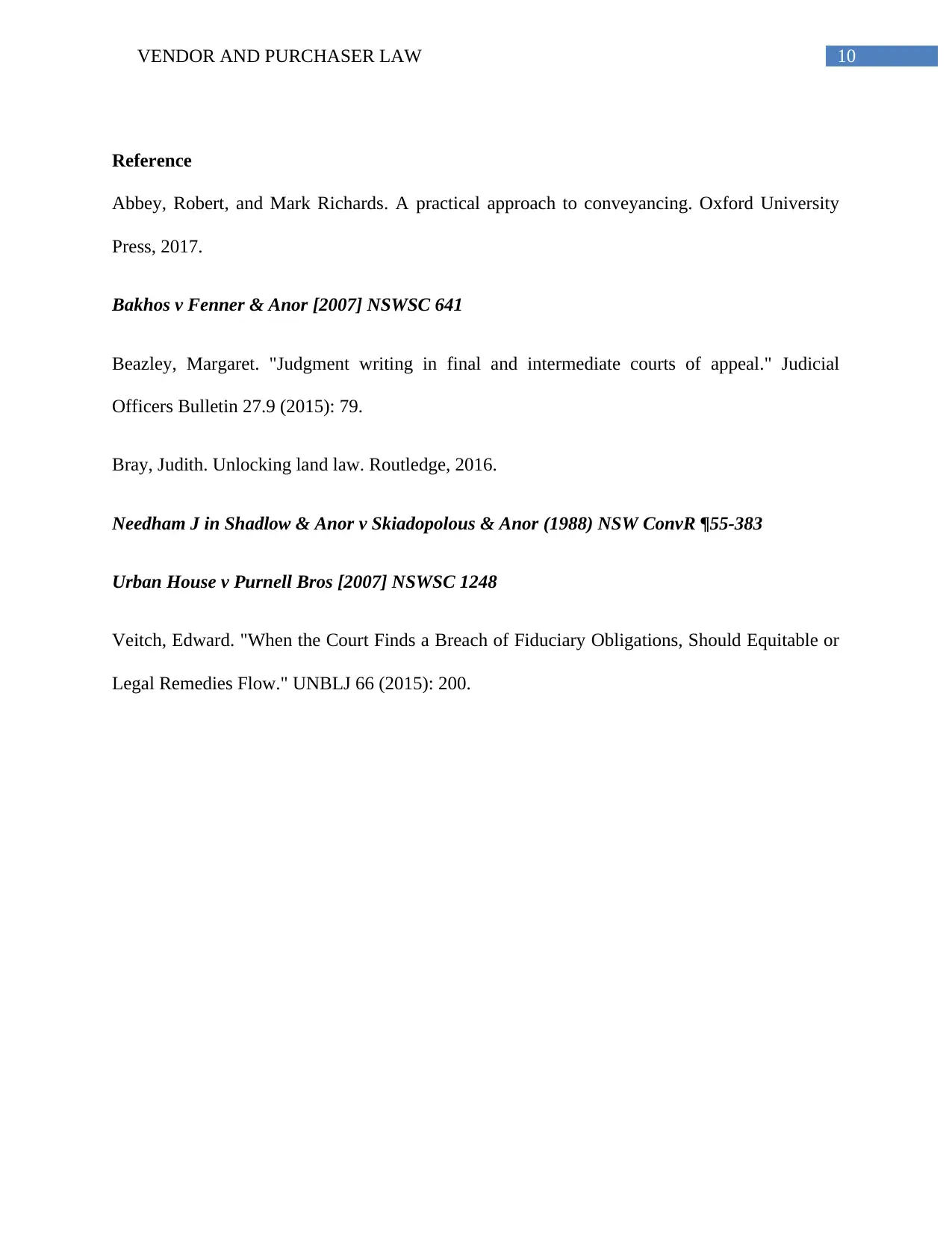
10VENDOR AND PURCHASER LAW
Reference
Abbey, Robert, and Mark Richards. A practical approach to conveyancing. Oxford University
Press, 2017.
Bakhos v Fenner & Anor [2007] NSWSC 641
Beazley, Margaret. "Judgment writing in final and intermediate courts of appeal." Judicial
Officers Bulletin 27.9 (2015): 79.
Bray, Judith. Unlocking land law. Routledge, 2016.
Needham J in Shadlow & Anor v Skiadopolous & Anor (1988) NSW ConvR ¶55-383
Urban House v Purnell Bros [2007] NSWSC 1248
Veitch, Edward. "When the Court Finds a Breach of Fiduciary Obligations, Should Equitable or
Legal Remedies Flow." UNBLJ 66 (2015): 200.
Reference
Abbey, Robert, and Mark Richards. A practical approach to conveyancing. Oxford University
Press, 2017.
Bakhos v Fenner & Anor [2007] NSWSC 641
Beazley, Margaret. "Judgment writing in final and intermediate courts of appeal." Judicial
Officers Bulletin 27.9 (2015): 79.
Bray, Judith. Unlocking land law. Routledge, 2016.
Needham J in Shadlow & Anor v Skiadopolous & Anor (1988) NSW ConvR ¶55-383
Urban House v Purnell Bros [2007] NSWSC 1248
Veitch, Edward. "When the Court Finds a Breach of Fiduciary Obligations, Should Equitable or
Legal Remedies Flow." UNBLJ 66 (2015): 200.
1 out of 11
Related Documents
Your All-in-One AI-Powered Toolkit for Academic Success.
+13062052269
info@desklib.com
Available 24*7 on WhatsApp / Email
![[object Object]](/_next/static/media/star-bottom.7253800d.svg)
Unlock your academic potential
Copyright © 2020–2025 A2Z Services. All Rights Reserved. Developed and managed by ZUCOL.





